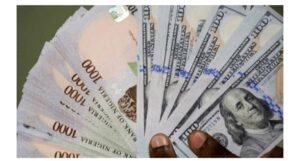
Photo Credit: Business Day
The Nigerian currency, the naira, has exceeded the N1160 mark against the US dollar in the parallel market, despite a significant decline in the US Dollar Index during the final trading session of the week. At its weakest point, the naira traded at N1670 to the dollar in major Nigerian cities, marking a worrying trend as the local currency continues to slide in value.
The depreciation is attributed to seasonal trends, with the Nigerian elite typically spending more on foreign travel and education fees for their children at this time of the year. These factors have compounded pressure on the naira, which already faces challenges due to underlying market dynamics.
Market Responses and Government Interventions
Earlier in the week, the naira recorded a brief recovery, gaining 4.8% on Wednesday after the Nigerian government successfully raised $900 million in its inaugural domestic dollar bond offering. This injection of foreign capital provided a temporary boost to the local currency, offering hope of stabilization. However, the positive momentum was short-lived, as a severe dollar shortage led to a sharp reversal of the gains, resulting in a 48% contraction in domestic dollar liquidity.
The prolonged dollar scarcity in the market continues to be a key driver of the naira’s volatility. Nigeria’s currency woes were exacerbated by President Bola Tinubu’s decision last year to eliminate currency regulations that had artificially overvalued the naira for years. The policy move, aimed at attracting foreign investment, has had the unintended consequence of exposing the naira to more market-driven forces, leading to its continued devaluation. Since the regulation change, the naira has lost more than two-thirds of its value against the US dollar.
Future Projections and Market Sentiment
According to a poll conducted by the Central Bank of Nigeria (CBN), businesses in Nigeria anticipate a further decline in the naira’s value in the remaining months of the year. However, optimism remains that the currency will regain strength in 2024. This view contradicts forecasts from leading financial institutions such as Renaissance Capital, Goldman Sachs, and the Financial Derivatives Company, which had predicted that the naira would stabilize around N1000 or lower.
Despite these varied forecasts, market fundamentals suggest that the naira’s trajectory remains precarious, influenced by both local and global economic conditions.
Global Dollar Dynamics: US Dollar Index Sinks Amid Rate Cut Speculation
In a related development, the US Dollar Index (DXY), which tracks the performance of the dollar against a basket of major global currencies, dropped on Friday as markets digested the week’s inflation data. The DXY’s decline was driven by growing expectations that the Federal Reserve may implement a significant 50 basis point interest rate cut during its upcoming policy meeting.
The shift in market sentiment was further amplified by remarks from former Federal Reserve officials, who hinted at the possibility of a more aggressive rate cut to address inflationary concerns. Market indicators showed that the DXY dipped below its 20-day Simple Moving Average (SMA) and hovered around the 101.2 support level, signaling a potential negative trend for the greenback.
Amid these developments, traders have begun to price in the likelihood of a 50-basis point cut, with the probability rising to 51% by the end of the week—up from just 15% at the start of Thursday. Additionally, projections for further rate cuts in 2024 have also been revised upward, reflecting heightened uncertainty in the global financial landscape.
While the US dollar struggled, it regained some of its losses on the back of positive consumer sentiment data. The University of Michigan reported an uptick in US consumer confidence in September, with its sentiment index rising to 69.0 from 67.9 in August. However, the outlook remains mixed as inflationary pressures persist.
The naira’s continued depreciation against the US dollar underscores the challenges facing Nigeria’s economy, particularly in managing its foreign exchange reserves and liquidity. As market forces and seasonal factors converge, the road ahead for the naira remains uncertain. With projections of further devaluation this year, the government and financial institutions will need to implement robust strategies to mitigate the currency’s slide and protect the Nigerian economy from deeper instability.
Credit: Nairametrics





